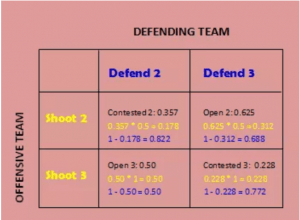Game Theory and Game Winning Shots in Basketball
Basketball is a sport loved by so many people around the world, and when it comes to the final game winning shot in a close game, its excitement is unparalleled to other sports. In the cited article, the author introduces a study by Shawn Ruminski. Ruminski links two situations on basketball court to his study. One is foul trouble which reduces the amount of time a player plays on court, and two is end of game scenarios, when a team that is down by two points has 20 seconds left to take the final shot of the game. This blog post will discuss about the second topic Ruminski introduces and how the concept he explains links to the material that the course has covered.
The situation he explains is when a team that is down by two has a possession with 20 seconds left in the game. It is logical for the team to wait until the final few seconds to take the shot to avoid giving one more possession to the opponents. Thus, assuming the losing/attacking team takes the final shot, the team has two options – take a two pointer to tie the game to go to overtime or take a three pointer to win the game. The chance of making a two pointer is higher than a three pointer, but obviously tying the game does not guarantee winning the game in the end. For the sake of the analysis, Ruminski assumed a team has 50% chance of winning when it goes to overtime.
The winning/defending team also has two options. It can strategize to defend a three point shot and risk giving up an open two-point shot, or vice versa. Ruminski collected data of league average percentage of both wide-open and contested two pointers and wide-open and contested three pointers. With the data, Ruminski build the following table.
The table suggests, however, that the game does not have either dominant or pure strategy equilibrium. The mixed strategy equilibrium is (p, q) = (0.670, 0.207), where p is the probability of the offensive team taking a two-pointer and q is the probability of the defensive team defending a two-pointer. Such equilibrium provides in-depth information about the game. Knowing the tendency of the other team’s coach helps the team strategize its attacking/defending plan. Of course, real-life situation is much different from the theoretical view as this one. Attacking team can still get an open shot even if the defending team defends the shot, and the chance of scoring the basket differs by the coach’s ability to create a play or a player’s ability to shoot the ball.
Nonetheless, it is still interesting that such a real life fascinating situation can be put into a game as learned in class. In fact, the decision making of real life players and coaches does reflect the process explained above but in a much more complicated manner. In fact, such an analysis can go further by analyzing the chance of scoring a two-pointer or a three-pointer for different teams. Some teams definitely have better skilled players and making game plans for each team in the NBA would be a fascinating experience for true fans of the game.
Reference: https://mindyourdecisions.com/blog/2012/06/19/game-theory-applied-to-basketball-by-shawn-ruminski/

